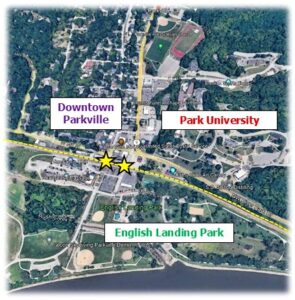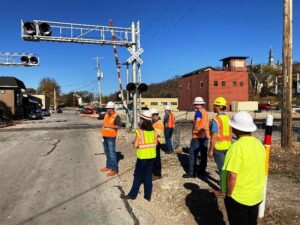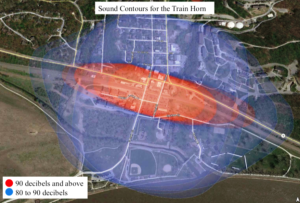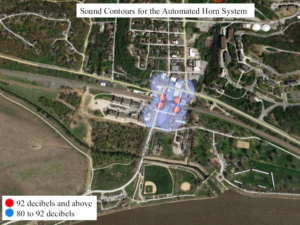Burlington Northern Santa Fe (BNSF) Railway Company is the largest freight railroad network in North America, operating 32,500 miles of Class I railroad track in 28 states across the United States, including a railroad track through Parkville. Every day, approximately 36 trains travel this route through Parkville and over the years, the location of the railroad tracks through downtown has negative impacts and issues including significant horn and train noise, vibration and blocking access in and out of English Landing Park and English Landing Center.

Historically, railroads have sounded locomotive horns or whistles in advance of grade crossings and under other circumstances as a universal safety precaution. In 2005, the Federal Railroad Administration established the Train Horn Rule, which set nationwide standards for the sounding of train horns at public highway-rail grade crossings. The rule also established a process for communities to obtain relief from the sounding of train horns by providing criteria for establishment of “quiet zones,” as well as implementation of wayside horns infrastructure, which is an alternative to a full quiet zone.
Wayside horns replace the noise from train horns (the overall sound is greatly reduced) and are positioned at railroad crossings to direct sound down the road. When a train approaches, the wayside horn activates and directs sound down the road. To utilize wayside horns, railroad crossings must still have — flashing lights, gates, constant warning time devices and power out indicators. While wayside horns do not eliminate warning noise, they are less costly and there is a reduction of noise over what is currently required by trains when approaching crossings.
Status Update(s):
- June 4 – Board of Aldermen approved agreement with MoDOT to receive Missouri Surface Transportation Block Grant funds for $540,000
Background
 The City held several work sessions to review the process for establishing a quiet zone in 2022. This ultimately led to execution of an agreement with BNSF to initiate the process for implementing quiet zone infrastructure. In November 2022, BNSF’s third-party consultant, Benesch, conducted an on-site diagnostic assessment with representatives from the City, BNSF and MoDOT to examine the crossing type(s), calculate risks and identify supplemental safety measures that can be implemented to mitigate risk. Based on the findings of the report, the City could discuss quiet zone infrastructure options as long as they meet Federal Railroad Administration requirements. Consensus from all parties involved was that wayside horn infrastructure would be the most suitable option for reducing the volume of locomotive horn noise at the railroad crossings through downtown.
The City held several work sessions to review the process for establishing a quiet zone in 2022. This ultimately led to execution of an agreement with BNSF to initiate the process for implementing quiet zone infrastructure. In November 2022, BNSF’s third-party consultant, Benesch, conducted an on-site diagnostic assessment with representatives from the City, BNSF and MoDOT to examine the crossing type(s), calculate risks and identify supplemental safety measures that can be implemented to mitigate risk. Based on the findings of the report, the City could discuss quiet zone infrastructure options as long as they meet Federal Railroad Administration requirements. Consensus from all parties involved was that wayside horn infrastructure would be the most suitable option for reducing the volume of locomotive horn noise at the railroad crossings through downtown.


Project Estimated Costs:
- Estimated cost: $675,000
- Engineering: $135,000
- Equipment: $300,000
- Right-of-Way: $0
- Other Costs: $0
- Utility Adjustment/Relocation: $0
- Program Implementation/Construction (incl. engineering/inspection): $132,000
- Contingency: $108,000
- State grant received: Missouri Surface Transportation Block Grant: secured $540,000
- Federal grant applications:
- Consolidated Rail Infrastructure and Safety Improvements (CRISI)
- US Dept. of Transportation Railroad Crossing Elimination (RCE)
- Active Transportation Infrastructure Investment Program (ATIIP)
